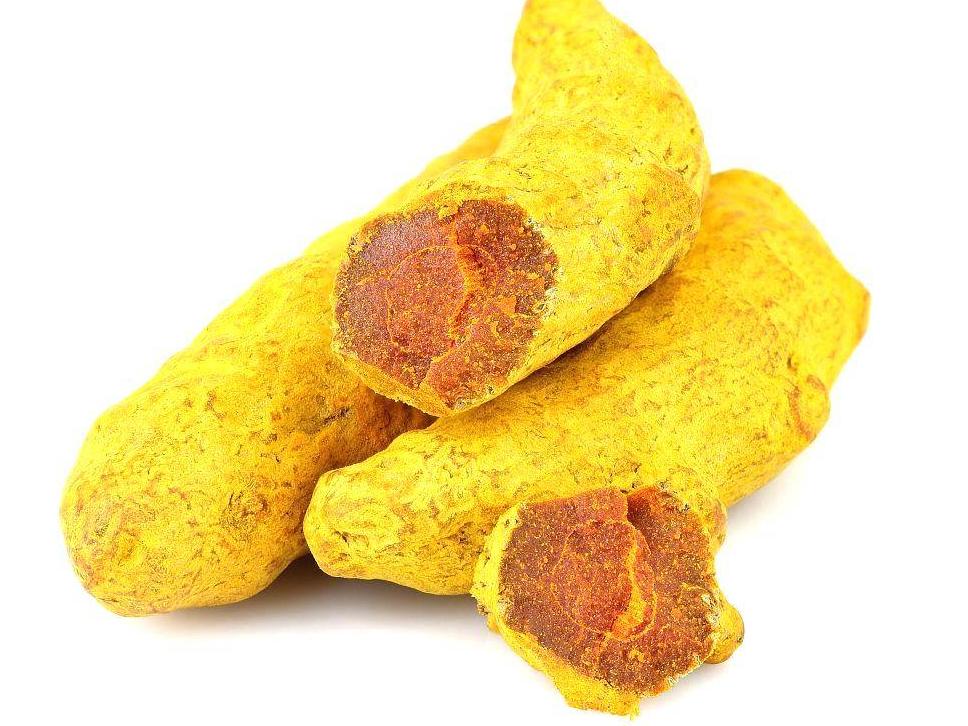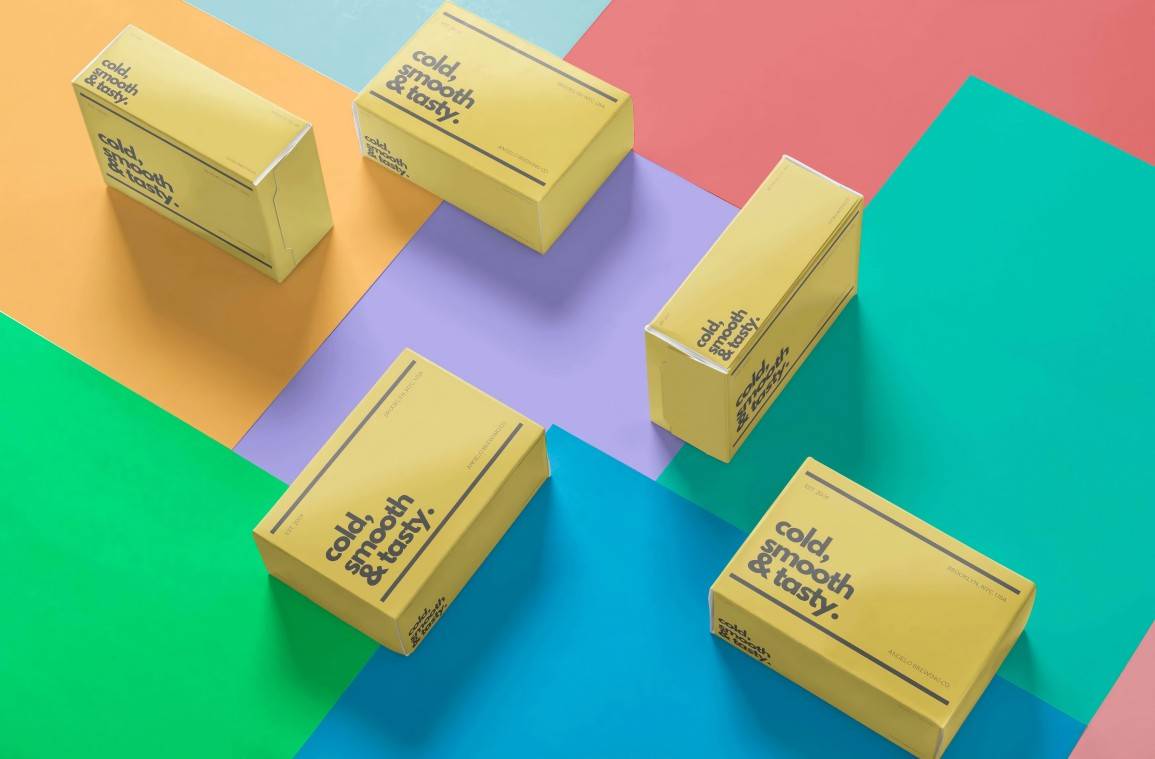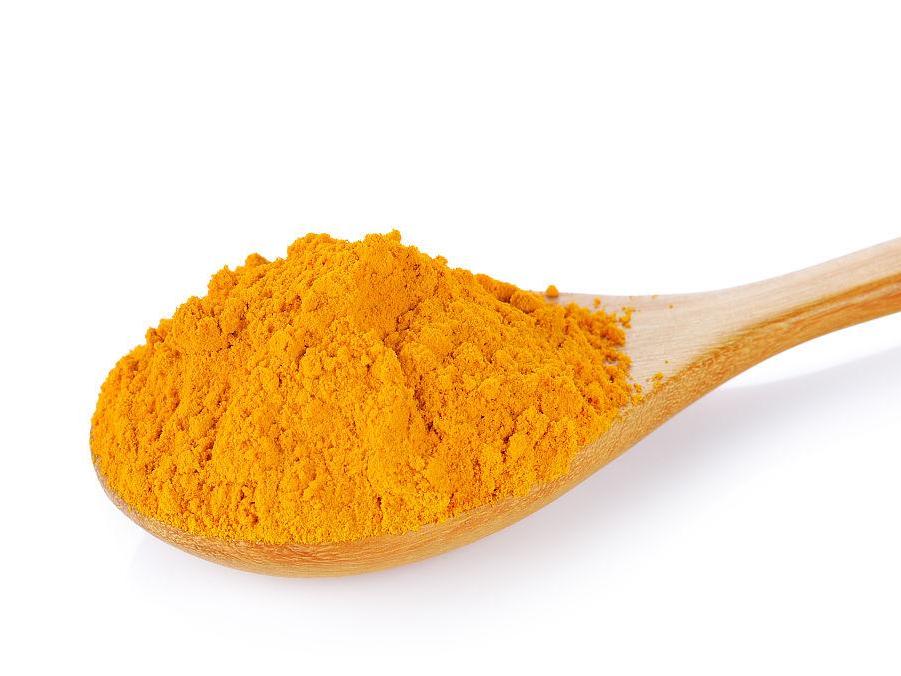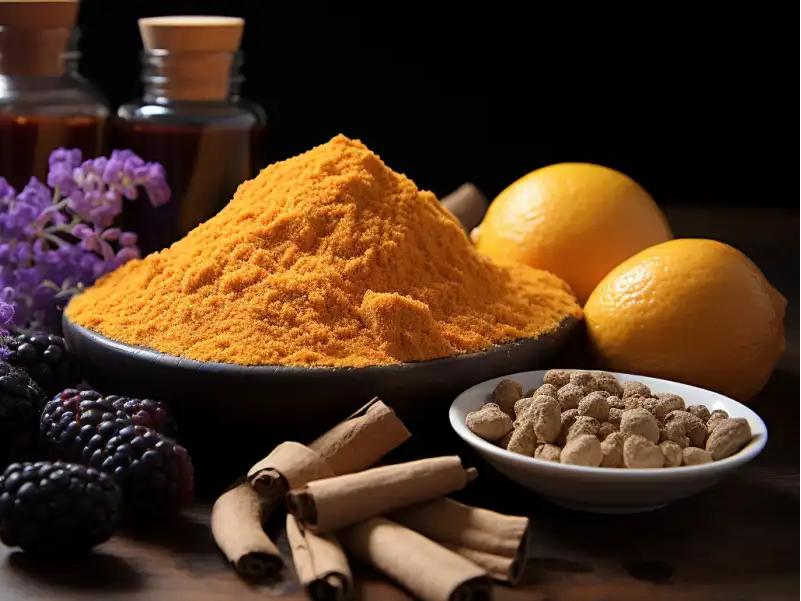What Is the Use of Turmeric Powder?
Turmeric is a perennial herb in the family Zingiberaceae, which grows in the subtropical regions of China. It is commonly used as a medicinal and edible ingredient and is mainly used as a food additive in the food processing industry [1]. Turmeric's main chemical components are terpenes and phenolic substances, and it also contains a small amount of alkaloids and other active ingredients. Currently, most research on turmeric focuses on the medicinal properties of curcumin compounds.
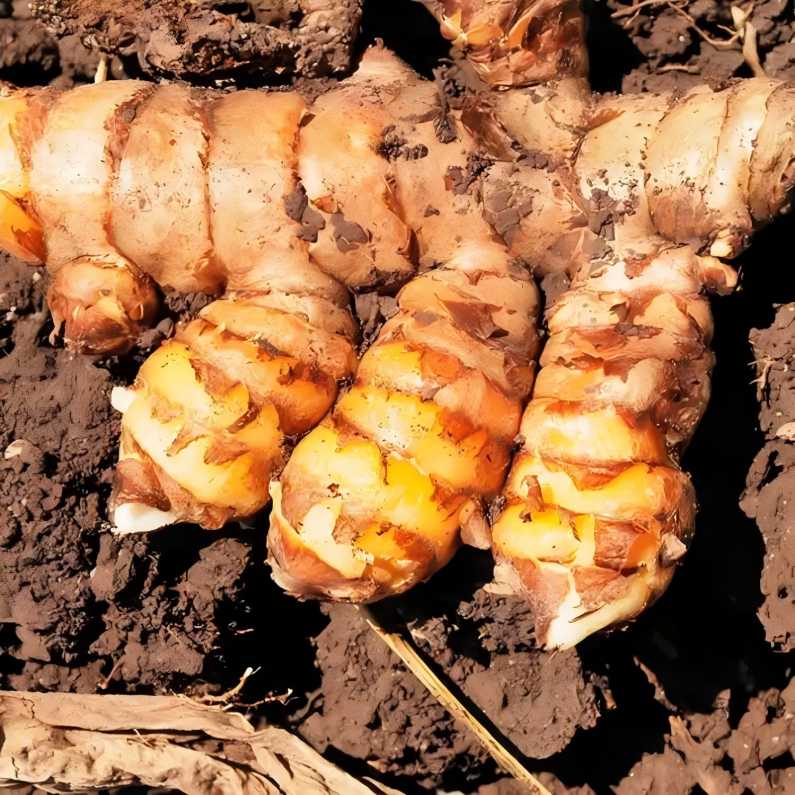
1 Chemical properties of curcumin
Curcumin, which is extracted from the rhizome of turmeric, is an important bioactive substance. It has been widely used as a medicinal plant and food additive for a long time. Its medicinal properties are attributed to the curcuminoids, including curcumin (curcumin I), demethoxycurcumin (curcumin II) and bisdemethoxycurcumin (curcumin III) [2]. Currently, curcumin I, curcumin II and curcumin III account for 77%, 17% and 3% of the curcumin used, respectively, along with some other compounds. Curcumin is a compound that is insoluble in water but dissolves well in organic solvents such as ethanol. The molecular weight of curcumin is 368 and its melting point is 183 °C [3]. The corresponding absorption values of curcumin in different organic solvents are also different. In methanol, acetonitrile, and ethanol, curcumin has the maximum absorption peaks at wavelengths of 450, 524, and 549 nm, respectively. Curcumin is prone to rapid degradation in phosphate buffer, with a degradation rate of 90% within 30 minutes [4].
2 The anticancer properties of curcumin
Curcumin has long been considered a health-promoting food ingredient. Numerous studies have shown that curcumin has anticancer activity and can be used as a preventive or therapeutic agent against cancer, either alone or in combination with chemotherapeutic drugs. Curcumin has a certain effect in cancer treatment, and can synergistically enhance the effect of chemotherapeutic drugs in cancer treatment and reduce the toxic side effects caused by chemotherapeutic drugs [5]. Curcumin is also a well-known anti-inflammatory substance, and cancer often occurs in chronic inflammatory conditions, so curcumin has also become a commonly used drug for preventing precancerous conditions. Unlike most chemotherapeutic drugs, which act at specific stages of cancer development, curcumin acts at all stages of cancer development (oncogene activation, cell proliferation, metastasis and apoptosis) [6].
Cancer development is associated with genetic instability, and oncogenes are the main modifying factors of many target genes. Mutations in oncogenes have been found in many tumor diseases. Oncogene deregulation is the first step in tumorigenesis. Studies have shown that curcumin has a certain inhibitory effect on oncogenes, mainly inhibiting the downstream effectors of oncogenes. Curcumin also exhibits anticancer properties that inhibit cell proliferation and induce apoptosis [7]. Curcumin has an anti-proliferative effect on cancer cells at different stages of cancer, against specific cell types, and at different concentrations. Low doses of curcumin cause cell cycle arrest, while high doses induce apoptosis. Cell proliferation is controlled by a variety of cell cycle regulatory proteins, in particular cyclins and the cyclin-dependent kinase family, whose expression is closely related to tumorigenesis [8].
Curcumin has the biological activity of inducing apoptosis, mainly through the mitochondrial death pathway, which causes cancer cell death. The use of curcumin in cancer therapy can enhance the drug toxicity of chemotherapeutic drugs against cancer cells. When used in combination with other cancer drugs, curcumin can be used as a chemosensitizer to overcome early chemotherapy resistance in cancer and reduce mortality. Many publications have reported the inhibitory effect of curcumin in the process of tumor metastasis. Tumor metastasis is a multi-step process that mainly includes tumor vascularization, cancer cell detachment, and increased cell invasion [9].
3 Anti-inflammatory activity of curcumin
Epidemiological research supports the theory that cancer usually originates from chronic inflammation. Chronic inflammation is now gradually becoming the seventh characteristic of cancer. Inflammation is an important physiological process in the body's response to injury. Under the action of biological enzymes and cytokines, inflammatory cells mediate the repair of tissue damage. There are both internal and external links between cancer and inflammation. The external pathway is induced by inflammation that promotes cancer development, while the internal pathway is driven by genetic instability. Experiments have shown that the use of curcumin can reduce the infiltration rate of neutrophils, inhibit lipid peroxidation, reduce serine activity, and inhibit the inflammatory response of colon cells [10].
Numerous studies have shown that NF-kB plays a key role in the development of chronic inflammation into cancer. NF-kB can be involved in regulating the expression of several genes involved in immune and inflammatory responses, as well as cancer cell proliferation and apoptosis. It is essential for the expression of a variety of inflammatory cytokines and adhesion molecules, and plays an important role in cancer cell proliferation by activating growth factor genes, oncogenes and cell cycle regulatory factors that promote cancer [11]. The chemical structure of curcumin contains many functional groups that can participate in antioxidant effects, helping to reduce and eliminate free radicals, reduce the production of reactive oxygen species, and thereby help reduce the production of lipid peroxides. Therefore, in addition to being used as an anti-inflammatory agent in the pharmaceutical field, curcumin is also often used in foods and cosmetics as an antioxidant.
4 The liver-protecting properties of curcumin
With its increasing incidence year after year, alcoholic liver disease continues to threaten human health. Alcohol-induced liver damage, if not treated effectively, can progress to liver diseases such as alcoholic fatty liver disease, alcoholic hepatitis and liver fibrosis. In the early stages of alcoholic liver disease, alcohol induces lipid metabolism disorders in liver cells, promoting the accumulation of lipids in liver cells and the formation of fatty degeneration of liver cells. Excessive lipid accumulation in liver cells affects the detoxification ability and growth of liver cells. The liver cells gradually lose their ability to remove toxic substances. Under the dual attack of harmful substances such as aldehyde, a product of alcohol metabolism, during the process of fat accumulation, liver cells begin to necroptose. Curcumin is used to regulate oxidative stress and the alcohol metabolism pathway to improve alcohol-induced liver damage. Experiments have shown that curcumin can reduce the hyperlipidemia induced by alcoholic liver disease, reduce liver steatosis, inhibit the transcriptional levels of FXR and Nrf2, and increase the expression levels of transcription factor mRNA [12]. Turmeric extract and curcumin can protect the liver by anti-inflammatory, antioxidant, and antifibrotic effects.
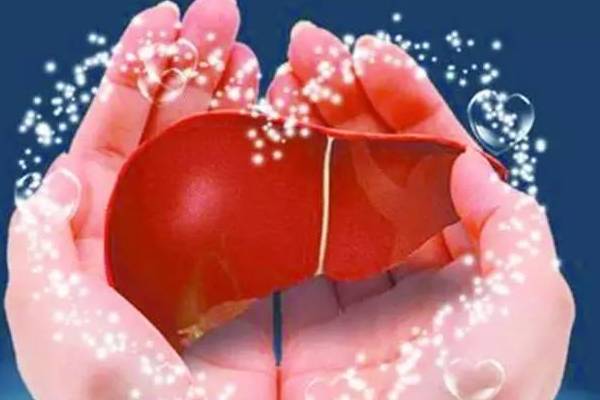
A rat model of liver damage induced by CCL4 showed that curcumin extract and curcumin inhibit liver ROS in acute and chronic stress, restore the altered ER folding state, regulate ER stress and the resulting liver lipid abnormalities, thereby promoting recovery from CCl4-induced liver damage [13]. Studies have found that curcumin can maintain liver antioxidant activity, inhibit lipid peroxidation, and inhibit the production of inflammatory cytokines after acute ethanol administration in mice, thereby effectively preventing acute ethanol-induced liver damage in mice [14]. Studies have shown that curcumin can be used in choline metabolism to increase the metabolism of fat in the liver, thereby preventing fatty liver [15]. Studies have found that curcumin can reduce CCl4-induced liver damage in carp by upregulating antioxidant activity and inhibiting the expression of NF-κB, IL-1β, TNF-α and IL-12. The results show that curcumin has a certain protective effect on the liver [16].
5. Turmeric in food
Turmeric is often added to animal feed as an additive. A large amount of experimental data shows that adding a certain dose of curcumin can stimulate the growth rate of aquatic fish fry, improve the immune system, enhance the body's own antioxidant capacity, and also have a certain bacteriostatic effect. A small amount of curcumin will improve the color of the fish and achieve maximum economic benefits during aquaculture [17]. A one-month turmeric feeding experiment was conducted on crucian carp, with turmeric mass fractions of 0–0.6%, using the growth rate of crucian carp as an indicator. The results showed that the addition of curcumin to the crucian carp feed can significantly increase the growth rate of the fish fry, and also stimulate the activity of proteases in the fish. As the amount of addition increases, the body mass, color, and length of the fish all show a positive correlation [18]. Antibiotics are often used in aquaculture to reduce liver disease in fish, but they can easily cause secondary enrichment. However, the use of curcumin can solve this problem and improve food safety.
Turmeric is a widely used Chinese herb in China, and has been recorded in traditional Chinese medicine works such as “Ben Cao Shi Yi” and “Ben Cao Gang Mu”. It is a plant that has been cultivated in India for more than 5,000 years and has the reputation of being a “panacea”. It was first used as a dye and later applied to improve digestion and relieve bone and joint diseases[19]. As its application fields continue to expand, from food to beverages to professional dietary supplements, turmeric-related products are being launched all over the world. According to a SPINS research report, sales in the United States reached 12 million US dollars in 2018. In 2019, Wahaha launched the turmeric drink Turmeric Wake Up, Golden Brew launched turmeric apple cider vinegar, and By-Health launched the turmeric hangover drink. Turmeric is not only used in the beverage sector, but also in the hot and cold cereal category, where it has also seen significant growth. Consumers of cereals are more interested in products with turmeric added to the label. At the same time, turmeric is being combined with probiotics to launch nutritional packs that maintain the body's immune system on a daily basis [20].
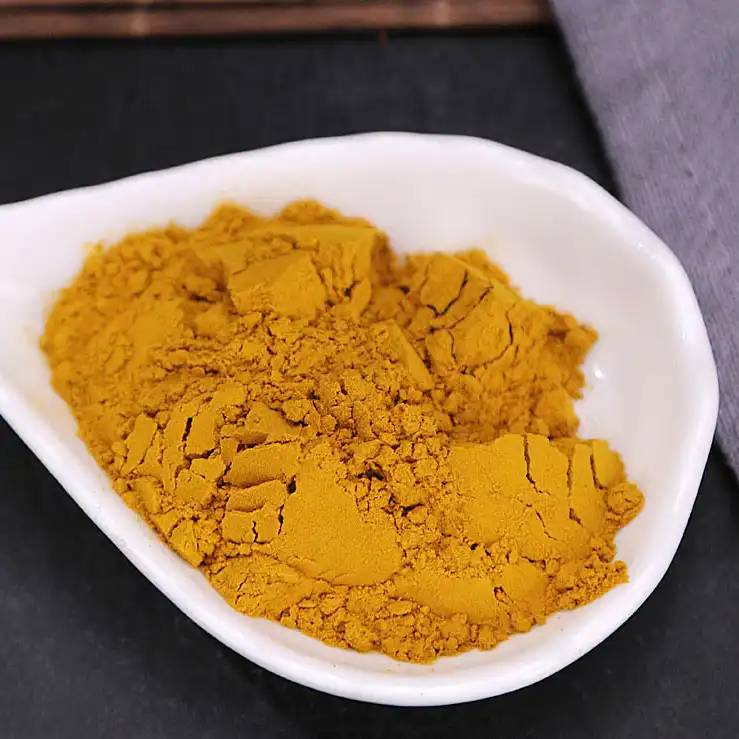
6 Conclusion
Curcumin has obvious medicinal value, has great potential in cancer treatment, and is increasingly accepted as a preventive therapeutic agent. It affects multiple processes of carcinogens and enhances chemotherapy resistance. The analysis summarizes the current medical and medicinal value of curcumin, and the results show that further in-depth research is needed in the application of food research, and the deeper functional mechanisms also need to be verified.
References:
[1] Chen Hua, Xue Changhao, Chen Tiehui, et al. Chemopreventive effect of turmeric and curcumin on acute liver injury caused by microcystin [J]. Chinese Journal of Pharmacology, 2005, 21 (12): 1517-1519.
[2] Sun Jingru, Feng Yuchao. Research progress on the biological functions of curcumin [J]. Agricultural Products Processing, 2020 (16): 67-71, 74.
[3] Tang Chuanhe, Peng Zhiying. Physiological functions and antioxidant mechanisms of curcuminoids [J]. China Food Additives, 2000 (4): 40-44.
[4] Wei Qin, Tao Zheng, Yonghui Yuan, et al. Intensification of the curcumin extraction process by ultrasound [J]. Journal of Tsinghua University, 1998, 38 (6): 46-48.
[5] Ren Erfang, Niu Debao, Xie Chaomin, et al. Progress in the development and application of turmeric [J]. Light Industry Science and Technology, 2014, 30 (10): 10-11.
[6] Aggarwal S,Takada Y , Singh S , et al. Inhibition of growth and survival of human head and neck squamous cell carcinoma cells by curcumin via modulation of nuclear fac- tor-kappaB signaling [J] . International Journal of Cancer, 2004 (5):679-692.
[7] Aggarwal B B , Shishodia S ,Takada Y ,et al. Curcumin suppresses the paclitaxel -induced nuclear factor -kappaB pathway in breast cancer cells and inhibits lung metastasis of human breastcancer in nude mice [ J] . Clinical Cancer Research ,2005 (20):7 490-7 498.
[8] Amanda M G , Robert A O. Curcumin and resveratrol in- hibit nuclear factor -kappaB -mediated cytokine expression in adipocytes [J] . Nutrition and Metabolism ,2008 (12): 1-13.
[9] Anto R J ,George J ,Babu K V ,et al. Antimutagenic and anticarcinogenic activity of natural and synthetic curcumi - noids [J] . Mutation Research ,1996 (2):127-131.
[10] Anto R J ,Mukhopadhyay A ,Denning K ,et al. Curcumin (Diferuloylmethane) induces apoptosis through activation of caspase -8 , BID cleavage and cytochrome c release : Its suppression by ectopic expression of bcl-2and bcl-xl [J] . Carcinogenesis ,2002 (23):143-150.
[11] Atsumi T , Tonosaki K , Fujisawa S. Induction of early apoptosis and ROS -generation activity in human gingival fibroblasts (HGF) and human submandibular gland carci- noma (HSG) cells treated with curcumin [J] . Archives of Oral Biology ,2006 (10):913-921.
[12] Azuine M A , Kayal J J , Bhide S V. Protective role of aqueous turmeric extract against mutagenicity of direct-act- ing carcinogens as well as benzopyrene-induced genotoxici- ty and carcinogenicity [J] . Journal of Cancer Research and Clinical Oncology ,1992 (6):447-452.
[13] Baldin V , Lukas J , Marcote M J , et al. Cyclin D1 is a nuclear protein required for cell cycle progression in G1[J] . Genes & Development ,1993 (7):812-821.
[14] Bava S V,Puliappadamba V T,Deepti A,et al. Sensitiza- tion of taxol-induced apoptosis by curcumin involves down- regulation of nuclear factor-kappaB and the serine/threonine kinase akt and is independent of tubulin polymerization [J] . The Journal of Biological Chemistry , 2005 (8): 6 301 - 6 308.
[15] Bhaumik S ,Anjum R ,Rangaraj N ,et al. Curcumin me- diated apoptosis in AK-5 tumor cells involves the produc- tion of reactive oxygen intermediates [ J] . FEBS Letters, 1999 (2):311-314.
[16] Chong Chen ,Huaiguo Xue ,Shaolin Mu. pH dependence of reactive sites of curcumin possessing antioxidant activity and free radical scavenging ability studied using the electrochemical and ESR techniques : Polyaniline used as a source of the free radical [J] . Journal of Electroanalytical Chemistry ,2014 (2):22-27.
[17] Lee B H ,Choi H A ,Kim M ,et al.Changes in chemical stability and bioactivities of curcumin by ultraviolet radia- tion [ J] .Food Science and Biotechnology , 2013 (2): 279-282.
[18] Zhao Y,Pan Y,Nitin N,et al.Enhanced stability of cur- cumin in colloidosomes stabilized by silica aggregates [ J] . LWT -Food Science and Technology,2014,58 (2):667 - 671.
[19] Patel A,Hu Y,Tiwari J K,et al.Synthesis and characterisation of colloidal particles [J] .Soft Matter,2010 (24):6 192-6 199.
[20] Nobuhara T ,Matsumiya K ,Nambu Y ,et al.Stabilization of milk protein dispersion by soybean soluble polysaccha- ride under acidic pH conditions [J] .Food Hydrocolloids, 2014 ,34 (1):39-45.


 English
English French
French Spanish
Spanish Russian
Russian Korean
Korean Japanese
Japanese